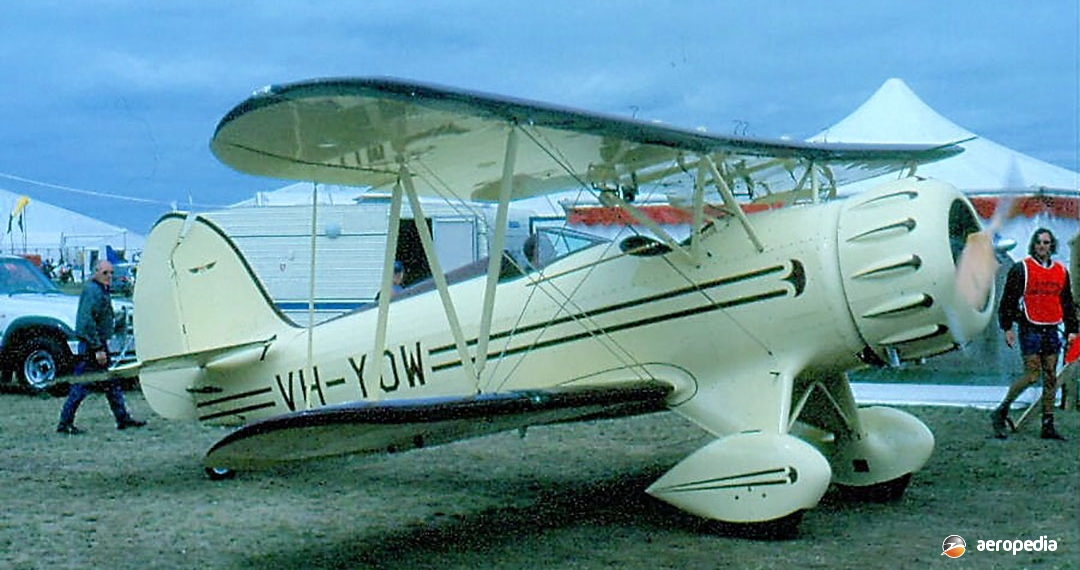Photograph:
Classic Waco Classic UPF-7 VH-YOW (c/n F5C-080) at Avalon, VIC in February 1999 (David C Eyre)
Country of origin:
United States of America
Description:
Three-seat sport biplane
Power Plant:
One 204 kw (275 hp) Jacobs R-755-B2 seven-cylinder air-cooled radial engine
Specifications:
- Wingspan (upper): 9.14 m (30 ft)
- Wingspan (lower): 8.18 m (26 ft 10 in)
- Length: 7.26 m (23 ft 10 in)
- Height: 2.59 m (8 ft 6 in)
- Wing area: 21.69 m² (233.5 sq ft)
- Max speed at sea level: 217 km/h (135 mph)
- Max cruising speed at sea level: 193 km/h (120 mph)
- Economical cruising speed at 2,440 m (8,600 ft): 177 km/h (110 mph)
- Stalling speed: 95 km/h (59 mph)
- Max rate of climb at sea level: 235 m/min (770 ft/min)
- Range with 30 mins reserve: 531 km (330 miles)
- Empty weight: 900 kg (1,985 lb)
- Loaded weight: 1,338 kg (2,950 lb)
History:
Due to the interest in 1930s vintage aircraft, and the lack of an adequate supply of survivors, a replica of the 1930s-era Waco YMF biplane has been developed and built by the Classic Aircraft Corporation at Battle Creek, Lansing, Michigan. The YMF in its day was a symbol of luxury mixed with adventure.
In 1979 it was decided to build new Waco YMFs and the original plans, which were in the hands of the Smithsonian Institute in Washington, DC were obtained. Former Piper engineers improved the design to modern standards, incorporating modern brakes, state-of-the-art electric systems, radio and modern corrosion-proofing techniques. They also made some alterations to the aircraft’s geometery and control system.
The construction of the first of the new build aircraft began in March 1984 using the original 1930s Type Certificate. The first aircraft (N1935B) flew on 20 November 1985 and new certification was received in March 1986.
In the United States examples have been fitted with De Vore Aviation PK3000 floats whereas the original 1930’s series had EDO M-2665 floats.
The new aircraft was what could be called a modern re-creation of Wacos 1934 design, featuring TIG welded 4130 steel tubing instead of gas-welded mild steel and a stainless steel firewall and metal skins on the fuselage to behind the rear cockpit. Ceconite 102 fabric covered the remainder of the aircraft and it was painted in Imron 5000 paint. An adjustable stabiliser was used for pitch trim and the tail assembly was braced by streamline wires above and below the stabiliser. The tail plane was balanced to reduce stick forces.
For easy starting of the engine, a battery/distributor ignition system was installed for the Jacobs R-755B-2 engine which was a re-manufactured original engine. This engine was of seven-cylinders, direct drive, normally aspirated with a carburettor, and provided 205 kw (275 hp) at 2,200 rpm driving a Sensenich W98JB4-68 two-blade fixed-pitch laminated wood 2.38 m (7 ft 9 in) diameter propeller.
Produced in two variants, the YMF-5 and the YMF Super, the latter had a larger front cockpit and enlarged forward door. Although looking like the original 1930s production aircraft produced by the Waco Aircraft Corporation, the new aircraft used modern construction techniques, tolerances and materials, the flying wires being stainless steel.
More than 80 have been delivered, a small number coming to Australia, the first becoming VH-MLX (c/n F5C-072) at Coolangatta, QLD, a second becoming VH YOW (c/n F5C-080) registered to its owner at Gruyere, VIC and a third, a YMF-5, becoming VH-ONY (c/n F5C-047 – ex N40138) at McLaren Vale, SA. An example described as a YMF-F5C became VH-YRB (c/n F5C105) on 1 May 2012 as Mosman Park in Western Australia. A further example, a YMF-5C, became VH-LFZ (c/n F5C096) on 20 November 2012.
In April 2013 an example was registered to Classic Flight Ltd of Wanaka, becoming ZK-CFL (c/n F5-019 – ex N60JG). A further YMF-F5C was imported to New Zealand. This aircraft N30AB (c/n F5C-8-129) was built in 2012 and was fitted with a 224 kw (300 hp) Jacobs R-755A2M radial engine. However, it was damaged when it suffered an engine failure and crashed into a freshwater lake at Travis, near Austin, Texas on 2 July 2016. It arrived in Tauranga where it has undergone restoration.

